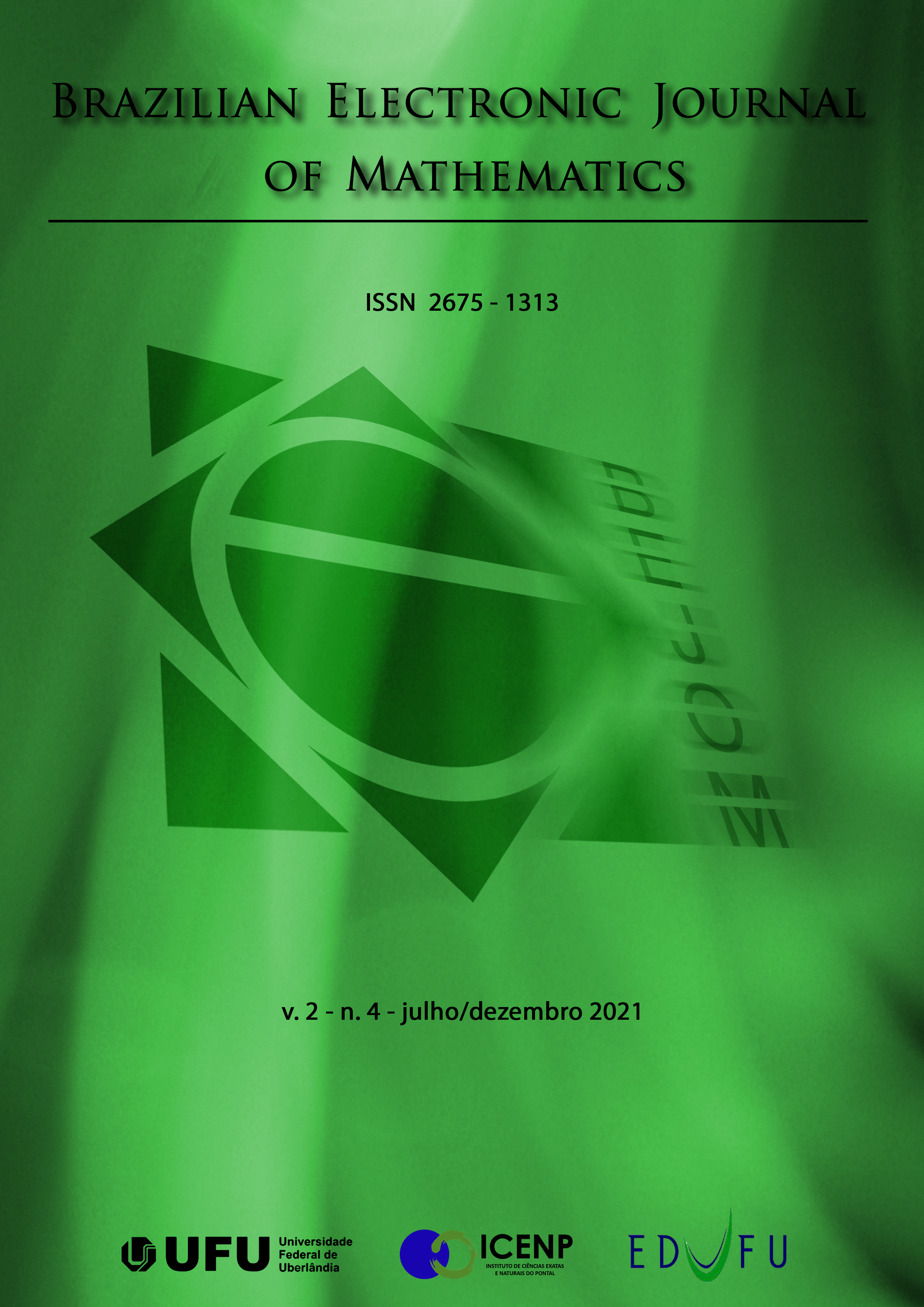The algebraic theory of quadratic forms applied to a dispute between two orixás
DOI:
https://doi.org/10.14393/BEJOM-v2-n4-2021-58457Keywords:
Algebraic theory of quadratic forms, quadratic forms, Brazilian Candomblé.Abstract
This is an brief and ludic introduction to the Algebraic Theory of Quadratic Forms, as presented in [1], and intermediated by fables or anecdotes from Brazilian Candomblé told in [2], in order to expose and strengthen the Theory of Quadratic Forms among the Brazilian community, because that this is a broad theory within Mathematics (for example, with connections in number theory and real algebraic geometry), and with important contributions made by Latin American mathematicians, such as the contributions of professors F. Miraglia and M. Dickmann in the articles [3] and [4], and the contribution of Professor M. Spira in the article [5]. The text focuses on presenting the initial concepts of the theory, such as quadratic form, quadratic spaces, elements represented by a form, discriminant, hyperbolicity, anisotropy and diagonalization of forms. After that, a fable is presented (inspired by the style of R. Smullyan in [6], and by the topological games) involving a dispute between Orixás solved through a game that uses elements of arithmetic in quadratic forms, as a ludic way of involving /interest the reader in the beautiful theory of quadratic forms through elements of Afro-Brazilian culture.
Downloads
References
LAM, T.-Y. Introduction to quadratic forms over fields. [S.l.]: American Mathematical Soc., 2005. v. 67.
PRANDI, R. Mitologia dos orixás. [S.l.]: Companhia das Letras, 2020.
DICKMANN, M.; MIRAGLIA, F. On quadratic forms whose total signature is zero mod 2nsolution to a problem of M. Marshall. Inventiones mathematicae, Springer, v. 133, n. 2, p. 243–278, 1998.
DICKMANN, M.; MIRAGLIA, F. Lam’s conjecture. In: SPRINGER-VERLAG 175FIFTH AVE, NEW YORK, NY 10010 USA. Algebra Colloquium. [S.l.], 2003. v. 10, n. 2, p. 149–176.
MINÁC, J.; SPIRA, M. Witt rings and Galois groups. Annals of mathematics, JSTOR, p. 35–60, 1996.
SMULLYAN, R.A Dama ou o Tigre? [S.l.]: Zahar, 2004.
HOFFMAN, K.; KUNZE, R. Linear algebra. 1971. [S.l.]: Englewood Cliffs, NewJersey.
SANTOS, D. F. Elementos da teoria algébrica das formas quadráticas e de seus anéis graduados. Dissertação (Mestrado) — Universidade de São Paulo, 2015.
WITT, E. Theorie der quadratischen formen in beliebigen körpern. Journal für diereine und angewandte Mathematik, De Gruyter, v. 1937, n. 176, p. 31–44, 1937.
DICKMANN, M.; MIRAGLIA, F. Special groups: Boolean-theoretic methods in the theory of quadratic forms. [S.l.]: American Mathematical Soc., 2000.
LAM, T.-Y. Orderings, valuations and quadratic forms. [S.l.]: American Mathematical Soc., 1983. v. 52.
ELMAN, R. S.; KARPENKO, N.; MERKURJEV, A. The algebraic and geometric theory of quadratic forms. [S.l.]: American Mathematical Soc., 2008. v. 56.
MILNOR, J. Algebraic k-theory and quadratic forms. Inventiones mathematicae, Springer, v. 9, n. 4, p. 318–344, 1970.
DICKMANN, M.; MIRAGLIA, F.Faithfully quadratic rings. [S.l.]: American Mathematical Society, 2015. v. 238.
DICKMANN, M.; MIRAGLIA, F. Algebraic k-theory of special groups. Journal of Pure and Applied Algebra, Elsevier, v. 204, n. 1, p. 195–234, 2006.
KNUS, M.-A. Quadratic and Hermitian forms over rings. [S.l.]: Springer-Verlag, 1991. v. 294. (Grundlehren der mathematischen Wissenschaften A Series of Com-prehensive Studies in Mathematics, v. 294).
DICKMANN, M.; PETROVICH, A. Real semigroups and abstract real spectra. i. Contemporary Mathematics, Providence, RI: American Mathematical Society, v. 344,p. 99–120, 2004.
ROBERTO, K. M. d. A. Multirings and The Chamber of Secrets: relationships between abstract theories of quadratic forms. Dissertação (Mestrado) — Universidade de São Paulo, 2019
Downloads
Published
Issue
Section
License
Copyright (c) 2021 BRAZILIAN ELECTRONIC JOURNAL OF MATHEMATICS

This work is licensed under a Creative Commons Attribution-NonCommercial 4.0 International License.
The published articles are licensed under the CreativeCommons CCBY-NC/4.0 version. By submitting the material for publication, the authors automatically waive their copyright, agree to the editorial guidelines of the journal, and assume that the text has been properly reviewed. Simultaneous submission of articles to other journals is prohibited, as is the translation of articles published in the journal into another language without proper authorization.









